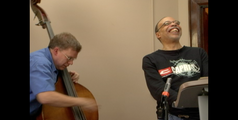Of Sunshine and Happy Endings: Jazz, Parody, and the Limits of Interpretation
Alan Stanbridge
Published: 2004-09-01
Given the complexities of his musical thought, the composer and music theorist George Russell has been a prime target for formalist analysis, which tends to emphasize his use of polytonality, his intricate rhythmic schemes, and his unique instrumental textures. But Russell’s 1962 and 1965 recordings of ‘You Are My Sunshine’ present themselves as something of a conundrum to such textualist formalism. The alternative, contextualist, view of the piece is usually based on the background information contained in the liner notes to the 1962 album, The Outer View. Following a trip to Sheila Jordan’s home town in the coal-mining region of Pennsylvania, Russell began experimenting with the tune, and in his notes Joe Goldberg suggests that Russell’s treatment “mirrors his impression of the humanity of the people pitted against the cold, bleak, often brutal demands of the region.
In this paper, Stanbridge argues that descriptions such as these ultimately fail to address the full range of potential musical meanings inherent in Russell’s parody of the original song, which can only be interpreted on the basis of a fuller understanding of the dialogical interrelationship of the musical texts – the earlier canonical versions (recorded by Gene Autry and Bing Crosby) and Russell’s contemporary readings – and their respective contexts. Stanbridge suggests that Russell’s earlier recording embodies an ambivalent tension which refuses a univocal reading, with Jordan’s affecting vocal performance entering into a complex ironic dialogue with its canonical predecessors, offering a new and radically unstable series of meanings and connotations, thereby denying definitive or categorical interpretation.
Available Files
-
Sunshine_and_Happy_Endings.pdf
Download


